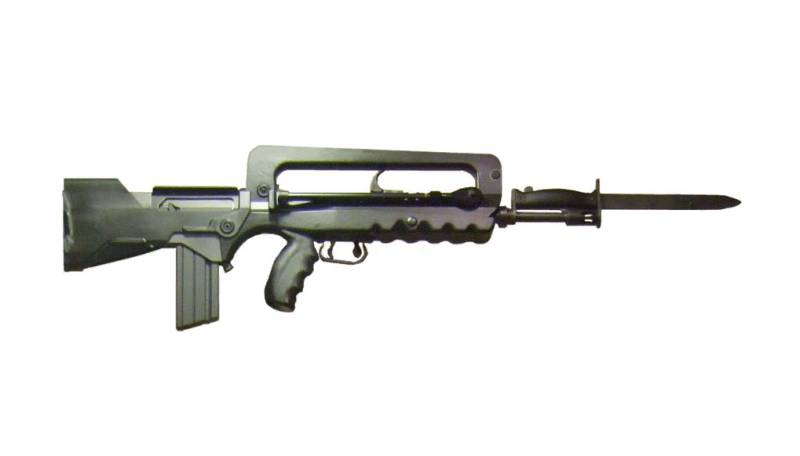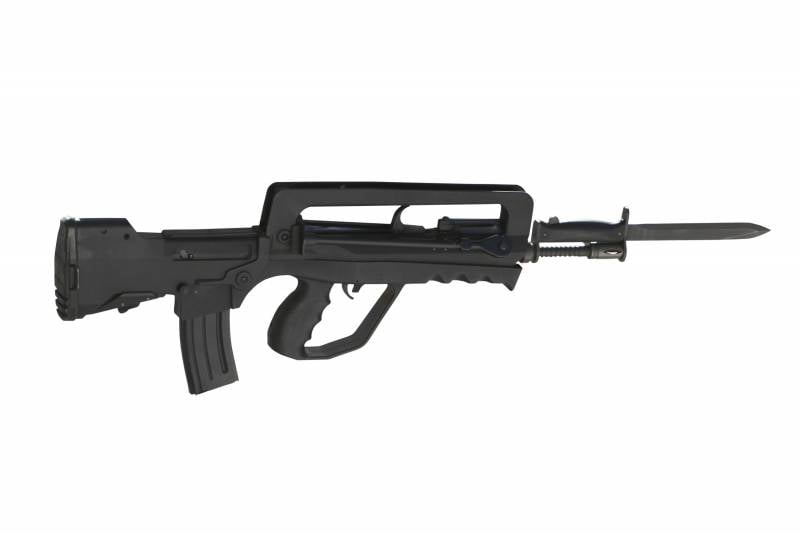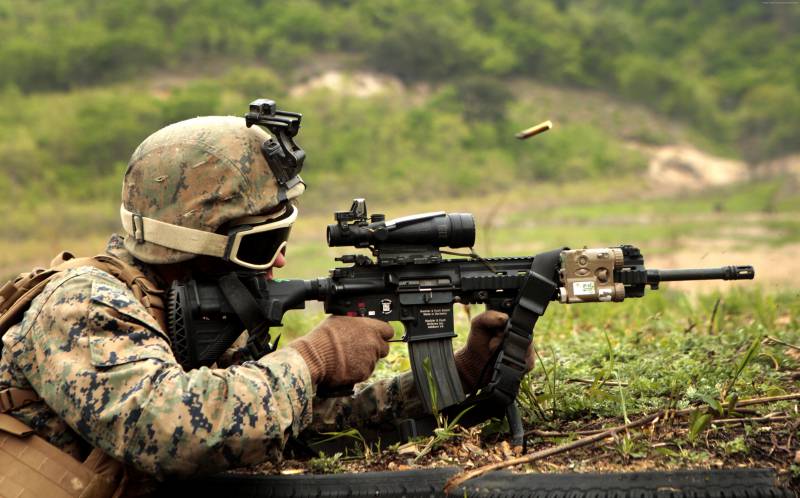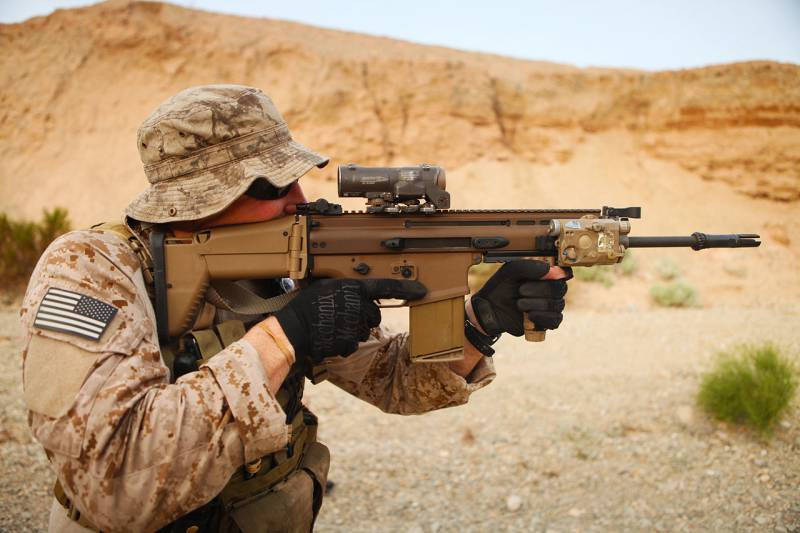AIF rearmament program news (France): search for a replacement for FAMAS is coming to an end
Currently, the FAMAS automatic rifle is in service with the French army. The operation of this weapon began in the late seventies and continues to this day. Due to their age, existing rifles are not fully satisfied with the military. In addition, the production of such weapons was stopped in the late nineties, which seriously complicates the continuation of their use by the troops. All these factors led to the fact that in the year 2012 it was decided to replace the FAMAS rifles with other weapons that meet the existing requirements.
To replace the available rifles, the AIF program (Arme Individuelle du Futur - “The Individual Weapon of the Future”) was launched. At the time of launch of the tender, it was planned to purchase 90 thousand rifles of a new type in the standard and shortened versions. It was necessary to offer the French army automatic rifle caliber 5,56 mm, capable of using rifle grenades, as well as having a number of other features. It should also be possible to integrate the rifle into the FELIN combat gear kit. It was assumed that by the middle of this decade, participants in the comparative tests would be identified who would be able to compete with each other. The first serial rifles were planned to be obtained in the 2017 year.
Five foreign companies submitted their applications for participation in the tender. The German firm Heckler & Koch offered the HK416 automatic rifle, the Belgian FN presented the SCAR-L, the Italian Beretta the ARX-160A1, the Swiss SIG the MCX rifle, and the Croatian company HS Produkt took part in the tender with the VHS K-2 sample. All participants in the competition handed over to the customer the documentation for their projects, and also presented ready-made weapons for testing.
During the first stage of the competition, the customer, represented by the French Ministry of Defense, studied the proposed samples and made certain conclusions. To date, the French military has made a preliminary selection and determined the finalists of the competition. At the beginning of July, there was information that the HK416 and FN SCAR-L rifles of the German and Belgian / American designs claim to be the replacement for the FAMAS rifle, respectively. These samples are fully consistent with the requirements, so now experts have to choose the most convenient and promising weapons that will be purchased for the army.
According to the latest data published by the French press, over the next month, specialists from the General Directorate of Arms, who are responsible for choosing the new systems for the army, must make the final choice. At the same time, the official announcement of the results of the AIF tender should take place later. This is expected to happen no earlier than November 2016 of the year and no later than January of 2017. There are no “leaks” of information or hints, which is why the result of the current contest remains secret.
The announcement of the results of the competition next winter will allow the French military to meet the original schedule. Shortly after the announcement of the results may appear a contract for the supply of the required small arms. It is noteworthy that over the several years of the AIF program, the wishes of the army increased slightly. According to recent reports, now the French military are going to get not 90, and 101 thousand rifles. As before, the weapon will have to be supplied in two versions, differing in size and weight. The first production rifles, made to order, can be delivered to France before the end of next year. The full implementation of the future contract will take no more than a few years.
The adoption of a new automatic rifle will be an important and noticeable step in stories french army. The existing FAMAS rifles have been in operation since the end of the seventies, and their production lasted for about two decades. It was released about 400 thousand such rifles, some of which have developed their resource. In addition, the military are no longer prepared to put up with some characteristic design flaws that impede the use of weapons.
The development of the FAMAS project (Fusil d'Assaut de la Manufacture d'Armes de St-Étienne - “MAS assault rifle from Saint-Étienne”) started in the early seventies and was associated with the adoption of the 5,56XXNNXX mm M45 low-impulse cartridge . The military wanted light and compact weapons with the ability to fire effectively at ranges up to 193 m and compatibility with rifle grenades. The design team of MAS, under the leadership of Paul Tellier and Alain Kube, completed the development of the first version of the new weapon in 300. Soon, another new model appeared, which differed from most analogs of that time in a reduced length.
The main original innovation of the project was the use of the bullpup layout, which did not have wide distribution in small arms. As a result of the use of such an arrangement, a significant reduction in the dimensions of the weapon was achieved. In addition, this led to an unusual appearance of the rifle. So, all the main weapon assemblies are placed in an elongated receiver with an extended rear part that performs the functions of the butt. In the central part of the box there is a pistol grip, behind it is a store receiving device. The carrying element became the recognizable element of the FAMAS rifle, which also served as the basis for the sights.
Another original feature of the rifle was the type of automation used. Unlike many other samples, FAMAS uses automation based on a semi-free shutter with lever deceleration. A comparative lightweight bolt connects to a heavier frame with a lever system, which allows it to be braked during movement under the influence of recoil shot. In accordance with the wishes of the customer, the valve has the ability to eject the liner in any direction. The unused receiver window is covered by a removable lid, also performing the functions of the butt cheek.
The weapon is equipped with a barrel length 488 mm with three grooves. Such a barrel bore configuration allows the use of 5,56x45 mm ammunition with various types of bullets with a rifle. The chamber is equipped with longitudinal grooves that facilitate the extraction of spent cartridges. At the muzzle of the barrel there is a flame arrester that improves the characteristics of the fire, as well as providing the use of rifle grenades.
With a total length of 757 mm rifle FAMAS, depending on the modification, weighs no more than 3,8 kg (without cartridges). The initial speed of the bullet reaches 960 m / s, the effective firing range is 450 m. Automation provides the technical rate of fire at the level of 1000 rounds per minute.
Initially, a modification of the FAMAS F1 rifle was supplied to the series. In the early nineties, the rifle was upgraded, resulting in the emergence of modifications G1 and G2. Weapons of different versions had some differences. In particular, the new rifle was able to use standard 30 magazine ammo instead of the original 25 ammo designed for FAMAS F1. Also produced versions of the rifle with a shortened barrel, several self-loading modifications, etc.
By the end of the nineties, the company GIAT Industries, engaged in the production of rifles FAMAS, fulfilled several orders for the supply of weapons to the French army and some foreign customers, "closing" all the needs for it. In the future, the manufacturing company carried out a number of production transformations, resulting in, among other things, the rejection of the further release of small arms. The GIAT leadership decided that maintaining production lines for rifles in the absence of orders for such weapons is not appropriate. A few years later, this led to the fact that France was forced to turn to foreign manufacturers for new weapons.
Two types of automatic rifles are currently being considered as a potential replacement for FAMAS: the German HK416 and the Belgian / Belgian FN SCAR-L. Interestingly, some French units already have experience in operating such weapons. Both samples have long been in service with the special forces of France, which have already used them in various operations. Thus, when choosing a replacement for an existing weapon, not only different characteristics, but also operating experience of the proposed systems can be taken into account.
The Heckler & Koch HK416 automatic rifle is a further development of the ideas embodied in the American M16 and M4 rifles. The German-made rifle uses a short-stroke gas automatics, and is also equipped with an improved version of the bolt used in the development of the United States. The rifle can be produced in several versions that have certain differences. For example, it is possible to manufacture products for cartridges 5,56x45 mm or 7,62x51 mm. There are also modifications that differ in barrel length, a set of additional equipment, etc. Thus, the customer has the opportunity to choose the version of the rifle that best meets his requirements.
Depending on the modification, the HK416 rifle has a length of no more than 950 mm and weighs (without cartridges) up to 3,9 kg. The speed of individual modifications reaches 850 shots per minute, the initial speed - up to 730 m / s. The target range varies from 200 m in shortened rifles to 600 m in full-size modifications. In all versions, box magazines are used on 20 or 30 cartridges, depending on the type of cartridge. Also rifles are compatible with stores of other types of high-capacity.
The SCAR-L automatic rifle project was developed at the beginning of the two thousandth by the US branch of the Belgian company FN Herstal to participate in the competition of the US Special Operations Command. At the end of 2004, the two versions of the SCAR family of rifles were put into service. Parallel exploitation of weapons for various cartridges continued until the 2013 year. After that, it was decided to leave the SCAR-H rifle chambered for 7,62x51 mm, and the SCAR-L for a low-pulse 5,56x45 mm was gradually decommissioned.
The SCAR-L automatic rifle is a weapon built on the basis of a gas engine with a short piston stroke. The piston is made as a separate part and is not part of the bolt carrier. Locking is done by turning the bolt and the interaction lugs. The rifle has a receiver, consisting of two main units. The top one is made of metal alloys and accommodates the bolt group, and also has barrel mountings that allow its replacement. The lower part of the receiver is made of polymeric materials.
A characteristic feature of the SCAR project is the use of a modular weapon architecture with the ability to change various parameters of the finished sample. Due to this, rifles with different barrel lengths and other differences in characteristics can be manufactured. With a length of up to 990, a rifle for a low-impulse cartridge weighs no more than 3,5 kg. It is possible to change the parameters of the stock and the installation of various additional equipment.
The rate of FN SCAR-L reaches 600-625 rounds per minute, the initial speed of the bullet - up to 870 m / s. It is possible to conduct effective fire at ranges up to 800. A standard NATO shop on 30 cartridges is used. Compatibility with other high-capacity ammunition systems is also ensured.
Both rifles, considered as a possible replacement for FAMAS, have already been the subject of a large number of contracts for the supply of weapons to one or another country. Among others, such weapons were ordered by France for a long time to special-purpose units. At the same time, HK416 and FN SCAR-L have a number of noticeable differences that can have a noticeable impact on the operation and, as a result, on the choice of a potential customer in the person of the French army.
After several years of comparisons, analysis of documentation and inspections of the products presented, the French armed forces decided on the finalists of the current AIF competition. In the near future, the army intends to choose a winning rifle of the tender, which in the foreseeable future will have to replace the existing FAMAS products of all modifications. The results of the tender will be announced at the end of autumn or in winter. Shortly thereafter, a contract for the supply of serial weapons should appear. What will be the decision of the Main Directorate of Armaments is not yet clear. Both selected models have both positive and negative features that can influence the final decision of the military and affect the future rearmament of the army.
On the materials of the sites:
http://journallessentinelles.com/
https://lenta.ru/
http://world.guns.ru/
http://heckler-koch.com/
http://bmpd.livejournal.com/




Information